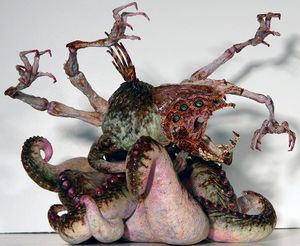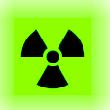Biohazard
A biohazard is any toxic material that can harm organic life. As with radiation exposure, biohazards can also create cool mutations like zombies, deformed monsters, and visceroids.
Since "biohazard" is a generic term, it can refer to many different types of things, but most of them are a glowing green liquid, stored either in poorly sealed (or completely open topped), rusty, leaking barrels or small glass flasks. Either of which may explode violently when damaged, but glass flasks are usually the safer of the two.
Only people in white lab coats should go near this stuff. Actually, sometimes even they should keep their distance...
Handle with care[edit | edit source]
Biohazards are very unpredictable. Sometimes a highly dangerous-looking stash of barrels can be as harmless as a pile of boulders.
Upon skin contact they are generally fatal, mutagenic, or at least very harmful (see levels below). However, if the same substance is injected into the bloodstream with a syringe, the effects are much more controlled, capable of turned an average man into a larger, stronger, faster being, albeit with suppressed intelligence.
Biohazards are sometimes installed into weapons. These most often come in the form of a spray or dart and either are really awesome or pretty much suck. It really depends on the manufacturer.
Drinking a biohazard could go either way. You'd best put a little in your friend's Mountain Dew first and see what happens. Since Dew is already green and rather harmful to one's health, if they keel over, you probably won't be blamed.
Past & Future[edit | edit source]
Biohazards didn't exist long ago, glowing green liquids from medieval time periods were usually a good thing.
Evil industries invented biohazards, but having no specific place in mind to store them, biohazards were left scattered around randomly much like explosive barrels, however, unlike their cousins, biohazards aren't stored in red barrels, they prefer yellow, green, or incredibly rusty metal ones.
Learn the difference between good green liquids and bad, it may save your life someday... or not.
In the future, zombies will take over the world due to biohazards. This is inevitable.
Biohazards will still not be stored more safely in the future however, that would ruin the fun now, wouldn't it?
Levels of biohazard[edit | edit source]
Biohazards are divided into four levels of toxicity determined by the odds you will mutate from contact.
- Level 1
These biohazards are completely harmless. You can swim in them, gurgle them, even use them as a lubricant.
- Level 2
Somewhat dangerous. If ingested or injected, may cause permanent mutations, but just touching the stuff, while not advisable, is safe.
- Level 3
Mutates or kills on skin contact. This class should be avoided as much as possible unless you are a robot.
- Level 4
Not only will this stuff mutate you, it will be highly contagious as well and can mutate anyone else that you associate with. Depending on the type of level 4 biohazard, spreading may require anything from mere proximity to requiring the infected to bite the flesh of the unaffected.
Biohazard or nuclear waste?[edit | edit source]
Sometimes it can be difficult telling the difference between a biohazard and nuclear waste as both are glowing green liquids that can kill/maim/mutate you.
You can tell if the object in question is nuclear waste if it has a radioactive trefoil symbol slapped on the side. If it doesn't, then it is a biohazard. Of course some biohazards are radioactive or have nuclear waste as a primary ingredient. In other words, who knows? It is either one or the other.
Since they look the same and have the same potential, does it really matter which is which?



